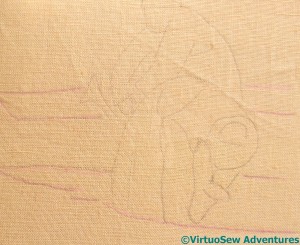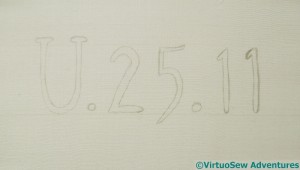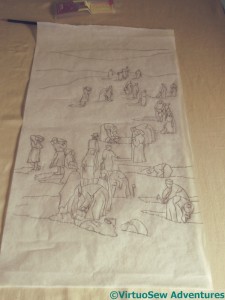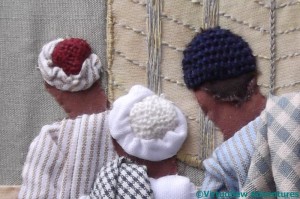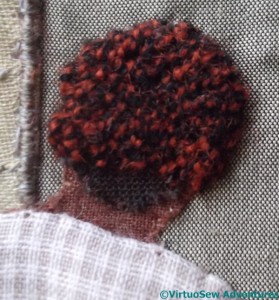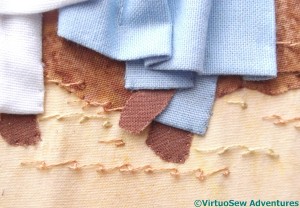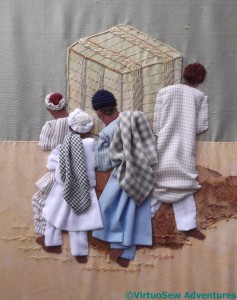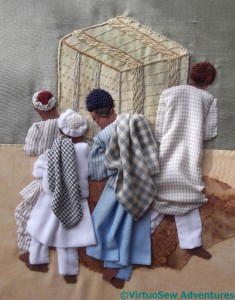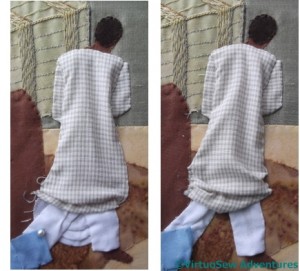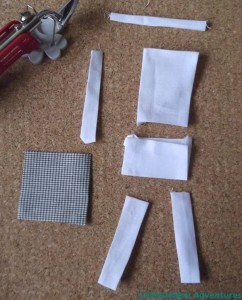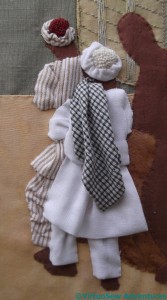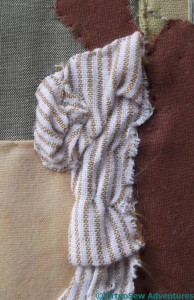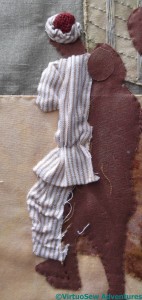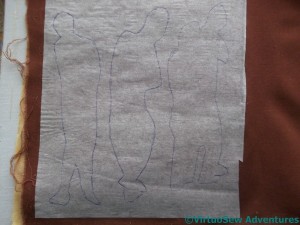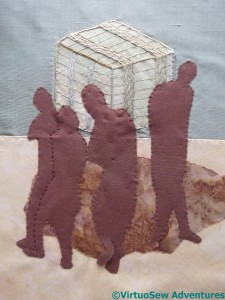Tag: Dreams of Amarna
Beginning to stitch the Panel of the Excavation
When I first looked at the picture of the Excavation, I realised that when I had only a small section on view, I was finding it hard to work out what was ground and what was human, so my first action was to go over the ground lines again, using a pinkish quilter’s pencil. It helped a little…
I decided next that if I could get the lines for the ground stitched, it should make decisions about stitching the humans easier. And those decisions need to be made a great deal easier, because since I transferred the design onto the fabric, I’ve stared at it, on and off, for weeks, wondering frantically how I was even going to start on it. I don’t usually suffer from this sort of bewilderment, so I’m in a terra incognita, here.
And truthfully, this isn’t as much help as I hoped. I’m working in the hand, because I find a lot of the basic stitches easier that way, and I am expecting it to be worked largely in line stitches.
The lines that have been stitched are all the ones in the design that indicate the ground surface (or, in the front, trenches and spoil heaps). There’s not enough structure here to help hold the panel together as I’m working on it, so I am going to have to think a little harder, work out a system for the people, and possibly completely rework the ground when I’ve done the people.
I know I can’t expect all my projects to flow as easily as did “Loading the Felucca”, but I really had hoped for a little less head-scratching and a little more stitching!
Stitching “Typed on Camelback in a Sandstorm”
The whole idea of this patch is to recall an incident that Mary Chubb describes, in which sand adhered to a freshly-typed page, creating “a rather pretty embossed effect”. In the end, I chose the grid reference of the Expedition House, where the team lived during the digging season.
I used a selection of silk threads from Mulberry Silks, from a colour family called “Old Cotswold”, which I’ve also used for the panel showing the Crock of Gold Hoard. It included a russet, a mid-grey and a very pale greyish-white as well as several sandy colours.
I used all of the colours this time, and discovered that the threads are not all the same, some being finer than others. That’s perfect in this case – some of the grains of sand would be finer than others, and I could accentuate or reduce the differences by using more or fewer wraps in my French Knots. I think it looks really very sandy indeed!
It took a remarkably short period of time. And what’s more, considering that I’m not really a fan of French Knots (I never could get the hang of them when I began embroidering), I rather enjoyed it. Although I must admit, it was beginning to get quite tricky, what with all those layers of thread. I swapped over to a sharp needle and even that was a struggle!
Still, that’s another piece completed…
And, as a bonus – an animation. This was put together by Simon Walters (@cymplecy on Twitter), using some photos I provided. I’m impressed with what he produced, considering that I didn’t take the pictures in a very controlled environment, and it will give you some idea of the view I had as I built up the effect, colour by colour
Thank you, Simon!
Typed on camelback in a sandstorm
One of the reasons Mary Chubb was sent out to Egypt with the Expedition was to ease the administrative burden in London by bringing the administration of the dig under control. In the nineteen twenties, of course, typing was not the mundane skill it has become, and although there was a typewriter in the Dig House, the excavation directors were not skilled in its operation, producing typed reports that looked, in Mary’s words, “as though they had been typed on camelback in a sandstorm”. The first task when a report arrived had always been to retype it into a more legible format so that no-one other than the secretaries would have to struggle to decipher it.
When she is out in Egypt, she soon discovers that some of the difficulties are not easily surmountable, even by an experienced typist. Sand adheres to the damp ink left by the typewriter ribbon, creating “a rather pretty embossed effect”, which sadly she isn’t always in the mood to appreciate, especially when dragged away from difficult, painstaking typing of lists to help with the excavation of delicate finds..
It was easy enough to work out how to represent the sand sticking to the paper – close-packed French knots in a mixture of sandy colours – but not so easy to decide what text to use. Maybe “faience”, a commonly used material for jewellery and ornaments? The names of the expedition members? References ascribed to finds?
In the end I settled on “U.25.11”, which was the site grid reference for the Expedition House, which was built up on the remains of an original house of the Amarna period. I don’t, of course, know precisely which typewriter Mary used, so I have sketched onto the fabric something that looks a little bit like typescript. It isn’t exactly right, but the letter and digit forms have been sketched from looking at the letters in a typescript we recently found, of an article my father wrote in the 1960s. My whole family is going to be involved in this project, whether they like it or not, and by whatever circuitous route I may devise…
Beginning on the panel of the Excavation
When you last saw the Excavation design, I had a rather blobby draft image, created with scissors, glue, and paper, and loosely based on one of the Egypt Exploration Society photographs. The pattern of shapes creates a pleasing effect, but there was more to do..
There followed the process of turning the design idea, layout, call-it-what-you-will, into an embroidery design. I outlined it onto tracing paper, took the tracing away from the paper, stood back and wailed.
None of the lines – taken from this image, I remind you – made sense.
Fortunately my mother (an artist, remember, with a much better understanding of figure drawing than I!) came to my rescue, emphasising some lines and removing others, tweaking and balancing the figures, and then finally I got the design transferred onto a piece of the sandy coloured linen.
Now I have to invent my stitched version, based on the lines transferred, but quite possibly inventing others as I go.
At the moment I haven’t the vaguest clue where to start, so this may be another case of “set it up and stare at it”.
I seem to do a lot of that!
Final Details on Loading The Felucca – for now!
Both of the labourers on the right have a small piece of dark brown cotton attached to their heads to give the impression of hair.
Two of the hats (the ones on the right) are turban-like things with a central section and a twist of fabric, and you’ve seen them before. They were really very successful, but the other two labourers seem to be wearing knitted or crocheted caps. Somehow trellis stitch didn’t seem quite right, so in this case I’ve used detached buttonhole stitch with return, in navy blue pearl cotton.
The final hat is much woollier. I used a heathered worsted yarn and trellis stitch. I have a few doubts about this one, but for now I’m content with it.
I was concerned that the dark cotton and the light background cotton were too distinct, and made too much of a contrast. My first efforts to break up the surfaces were not as successful as they might have been, but in due course I arrived at the solution – rows of scroll stitch using a single strand of thread, in tones that lie between the two extremes.
I’ve left the little foot unattached, dangling over the sandy surface and seeming to poke out of the trouser leg just as it should.
And behold the (nearly) final version.
I think there is just enough of the scroll stitch, and the packing case has almost the right level of detail to make sense, but not so much as to attract more attention than it should. The people have worked, if anything, even better than I hoped they would.
I’m going to wait until I know where in the Dreams of Amarna the piece is going to live – either as a patch on one of the main panels, or as a stand-alone, separate panel – before I do any more. At the moment, I don’t know what more to do, or how to do it, and until I do know, I’m not risking the success I’ve already had.
The Fourth Labourer
 Finally, after all that trouble with the Third Labourer, I moved on to the fourth.
Finally, after all that trouble with the Third Labourer, I moved on to the fourth.
After some playing around with colours, I decided to dye some of the fabrics I’d bought to clothe these fellows (Bahama Blue, if anyone wants to know!). It proved to me that some of the fabrics which I had expected to be cotton weren’t, but that doesn’t matter in this context. This project is going to be a positive riot of different materials!
You can see that I made considerable use of pins to control the fabric and keep the pleats in something resembling order, holding the fabric to be ironed, and simply leaving it while I thought about the next stage.
The stripy fabric for this fellow’s shirt is the same as the stripes on the first one, overdyed with the blue, and the bold blue check was overdyed with a stony beige colour, to try to make it look a little dusty. It barely made any difference, but sometimes “barely” is good enough.
I’m very pleased with the way the folds suggest the raised leg, and the turned in sections of the tunic create some bulk for the shoulders.
And, though I say it myself, I think the folds of the shawl (if that’s what it is) are an absolute triumph. They are secured in a few places, but I defy you to find the stitches, even if you zoom in on the picture, and I’ve avoided crushing any of folds.
The basic figures are now completed, and I’m really rather pleased with how they’ve turned out, but I do feel as though there may be some details missing.
More staring and thinking required…
The Third Labourer
The mini-iron has been very helpful in turning and pressing the edges of the fabric pieces – sometimes before they’re applied, and sometimes afterwards, but at first I was very surprised to find myself wielding it left-handedly, more often than not. Then a little further thought, and it made sense – the difficult part is controlling the fabric, so naturally I would use my better hand.
First of all I started on the middle figure, forgetting that he is the nearest to the camera. So I stopped working on him – leaving his trouser bottoms in place – and moved on to the figure on the right.
Then the pleated drape cause me a great deal of trouble. Then I wasn’t sure about the left leg. Then I realised that I’d used the checked fabric I was intending for the overshirt.
More unpicking. Grr!
I reinstated the trousers and the drapery in white fabric and then started trying to fit the overshirt.
I’ve been making extensive use of that set of pins that Karen Ruane sent me (thank you again, Karen – they’ve been invaluable!) as I try to work out how to make the overshirt sit properly.
In this case, however, having pinned and stitched, and unpicked and pressed and restitched, I decided I still had some reservations.
Still more unpicking.
Grr yet again!
So after much more puzzling and unpicking and re-stitching, I think I’m happier now. I’ve reduced the bulk in the left shoulder, removed the drapery, which is in the photo but didn’t “read” well in the applique, and reworked the overshirt.
Again.
None of the lower edges have been caught down, which I hope will help create the proper effect of garments that can move around a body. That does mean, of course, that I will have to be very careful not to crush the final piece when I’m storing it, but I do think it will be worth the effort!
Dressing the Second Labourer
Since I decided after dressing the first labourer that using rectangles of fabric was the way to go, when I started on the second I began by cutting out every bit that I expected to need.
That meant:
two pieces for the legs, a piece for the body of the top, a piece for the section of the top below the waist, a piece for the turban, a piece for the sleeve, and a piece for the cloth thrown over the shoulder.
I bought myself a mini-iron to make the job of folding in the edges easier, lighter, and less perilous. Fortunately there are two more labourers to dress, so I will have plenty of time to improve my skill!
The trick to a successful applique is the order in which the elements are layered.
So in this case, the first pieces are the trousers. They are stitched down each side, and tweaked in the middle to create some impression of a body underneath. The bottom edges aren’t held down, so in storage this piece may be a bit delicate.
The turban is done in just the same way as the first one, but this time I used a cream linen thread for the central disc.
The sleeve was next, and then the “skirt” of the top, which is gathered to give it a sense of bulk. It is tethered by the underlayer, but not attached at the bottom edge. The right-hand edge isn’t tethered, either, because in due course the Third Labourer’s clothing needs to fit underneath..
Finally, there was the body of the top, and the fabric thrown over the shoulder. I don’t understand why he didn’t use it to pad his shoulder against the packing case, but the photo says he didn’t!
Dressing the First Labourer
Having stared thoughtfully at the people, I cut out some clothing shapes out of one of my pieces of quilting cotton, and started trying to create folds in them as I attached them to the fabric.
The trousers were tricky, but not impossibly so. The jacket, or top, or whatever it is, brought me to an abrupt halt.
Dearie, dearie me.
That didn’t work at all, did it.
The bulk and the folds are all in the wrong places. He’s certainly crumpled, but it isn’t the right sort of crumpled! And don’t even get me started on how difficult it was. I felt as though I was all fingers and thumbs – it was almost as bad as working with glue!
Cue much muttering, unpicking, and rethinking.
While I was thinking, I had a go at the turban.
The textured deep crimson is a circle of trellis stitch, a densely knotted needlelace stitch I’ve used a lot in my various Thistle Threads courses. The thread is silk, from a bag of “odds and ends” from Mulberry Silks. I cut out a circle of the fabric I’d stitched and gathered it to create a crimson bobble.
The cotton around it is a narrow tube of the fabric I was using, tucked under the crimson bobble at either end, and held down with odd little stitches to create the effect of folds.
That worked. It also gave me a thought. There seems to be very little shaping in the garments we see in the photos from the dig – not least, in such a hot climate, loose, airy, voluminous clothing is likely to be a lot more comfortable!
So the next version of the labourer’s clothing was made, essentially, by cutting out a series of rectangles and applying them separately. In this case, there was only one rectangle for the sleeve, and then another for the body. It’s been gathered in to create a loosely bloused waist, and left flat and unfinished on the inner side where it will be covered by the next labourer’s clothing.
I think this has worked a great deal better. I might even be able to bring my imagined picture almost fully to life!
I’ve also added another layer for the face of the second labourer. There won’t be much of it visible, but the first labourer’s clothes are supposed to be behind it, so the addition was necessary.
Beginning the People
Once the packing case was in place it was time to put the people on. I’ve used iron-on transfer adhesive to stabilise the cotton fabric for the people. It isn’t likely that I will make use of the adhesive, but at least the tracing paper on the back allowed me to draw outlines of the people to cut out.
There was a brief pause while I made quite sure that I had traced the people the right way round to ensure that when I put them on, the fabric side would be uppermost and not the glue side, then I cut them out..
Attaching the people was fairly straightforward, using single strands of silk pulled from a bundle of odds and ends. I even tacked them in place with silk – which just shows how cavalier I have become since working with metal threads and Gilt Sylke Twist!
Very little of these cotton people will show once I’ve dressed them. They are there for two reasons – because I felt that it would be easier to do that dressing if I had some sense of the bodies beneath, and because I know from working on the Camberwell Panel that small bits are hard to place precisely, especially in conjunction with other small pieces. Since the people are inside their clothes, putting the heads and feet on last would put them out of kilter in comparison with everything else.
I have cut and left unattached one foot of one of the people because I need to put a trouser leg behind it, and roughly stitched a line between the two people I’ve cut out as a single piece of fabric. That should help me to ensure that when I dress the furthest of them, I don’t use more fabric than I need, or create a finished, turned edge that adds thickness where I don’t want it.
Now I need to stare thoughtfully at the photograph for a while and work out just how to approach the next stage.

